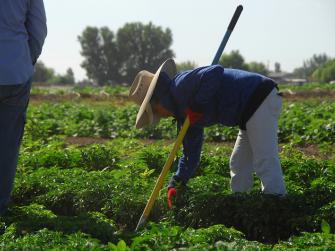Heat stress threatens agricultural workers’ health as U.S. temperatures rise
EDF and La Isla Network report details what is needed to protect farm labor from dangerous heat

More than 2 million farmworkers play an integral role in the U.S. food system, contributing to the countless fruits, vegetables and grains that line our local grocery store aisles. This essential group is at exceptionally high risk for heat-related illness due to the strenuous nature of their work, which primarily takes place outdoors. This risk is growing as record-breaking temperatures become more frequent and persistent due to climate change. Climate adaptation measures will need to center justice and equity to protect those that are vulnerable and underserved, including farmworker communities.
Farmworkers are at exceptionally high risk for heat-related illnesses
Mortality from heat-related illness is 20 times higher for crop workers in the U.S. than private industry and non-federal government workers. The average U.S. agricultural worker is currently exposed to 21 working days in the summer growing season that are unsafe due to heat. Farmworkers would experience an additional 18 days of work above safe heat levels if emissions peak before mid-century and then slowly decline. This number will only grow with additional warming.
The farmworker community faces unique vulnerabilities that make them more susceptible to heat stress than the average U.S. worker. Factors including low wages, social and cultural isolation, barriers to medical care, substandard housing and inadequate regulatory standards make it difficult to prevent and treat heat-related illnesses within the U.S. farmworker community.
The U.S. needs a federal heat standard
Current heat standards are inadequate to protect farmworkers in the U.S. A growing number of states and employers have implemented their own heat standards for farmworkers and outdoor workers that require water, rest and shade —fundamental workplace safety measures for heat illness prevention. However, the U.S. also needs a federal heat standard. This would set an enforceable benchmark that protects farmworker health and clarifies employers’ responsibilities nationwide.
Did you know?
In the U.S., the average farmworker already experiences 3 weeks of dangerously hot working conditions per year.
MEDIA CONTACT
Deja Curtis
(202) 695-3110 (office)













